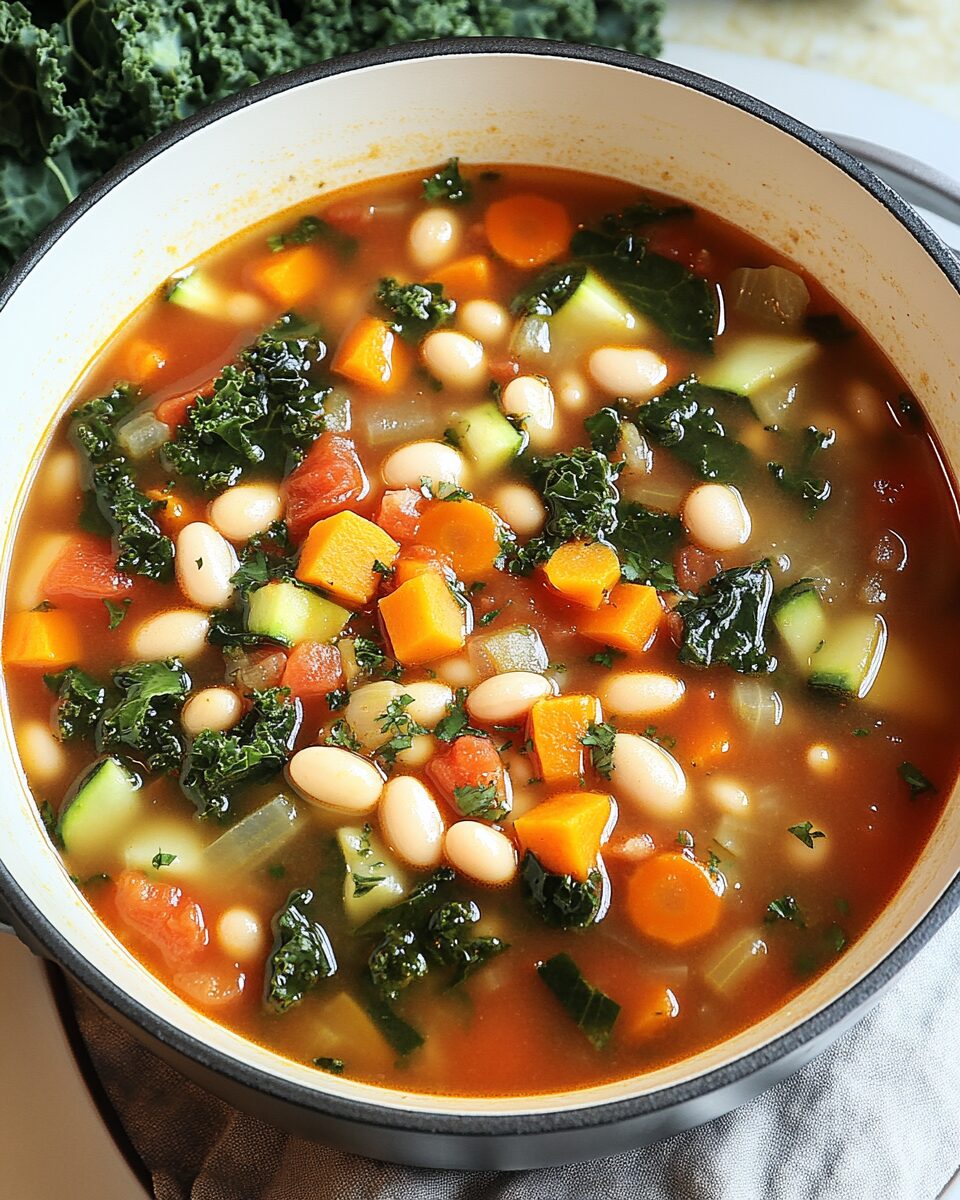The Winter Minestrone is a comforting, Italian-inspired soup loaded with colorful vegetables, two types of hearty beans, and tender pasta. Perfect for chilly days, this soup delivers deep, savory flavors in every spoonful while remaining completely meatless. Topped with a sprinkle of Parmesan and a drizzle of olive oil, it’s as beautiful as it is satisfying.
This minestrone is the definition of a one-pot wonder, making it ideal for both busy weeknights and lazy weekends. It’s easily customizable switch up the greens or use whole wheat pasta for an added nutrition boost. Plus, it stores and reheats like a dream, which means leftovers are just as delicious. Whether you’re feeding a family or meal prepping for the week, this is a winter recipe to keep in your regular rotation.
Full Recipe:
Ingredients:
-
2 tablespoons olive oil
-
1 onion, chopped
-
2 carrots, peeled and chopped
-
2 celery stalks, chopped
-
1 small zucchini, chopped
-
1 small sweet potato, peeled and chopped
-
3 garlic cloves, minced
-
1 can (14.5 oz) diced tomatoes with juice
-
1 can (15 oz) cannellini beans, drained and rinsed
-
1 can (15 oz) red kidney beans, drained and rinsed
-
4 cups low-sodium vegetable broth
-
1 cup water
-
1 teaspoon salt
-
1/2 teaspoon freshly ground black pepper
-
1/2 teaspoon dried thyme
-
1 bay leaf
-
1/2 cup small pasta (like ditalini or elbow)
-
1/2 cup frozen peas
-
2 cups chopped kale or Swiss chard
-
1/3 cup freshly grated Parmesan cheese
-
1 tablespoon olive oil (optional for drizzling)
-
Fresh basil or parsley for garnish (optional)
Directions:
-
Heat 2 tablespoons of olive oil in a large pot over medium heat. Add the chopped onion, carrots, and celery. Sauté for 5 minutes until vegetables are slightly softened.
-
Stir in the zucchini, sweet potato, and garlic. Cook for another 3-4 minutes.
-
Add the diced tomatoes with juice, cannellini beans, kidney beans, vegetable broth, water, salt, pepper, thyme, and bay leaf. Stir well.
-
Bring to a boil, then reduce heat to low. Cover and simmer for 25-30 minutes until vegetables are tender.
-
Stir in the pasta and frozen peas. Cook uncovered for 8-10 minutes, or until pasta is al dente.
-
Add the chopped kale or Swiss chard and cook for 2-3 more minutes until wilted.
-
Remove bay leaf. Taste and adjust seasoning as needed.
-
Ladle soup into bowls. Sprinkle with grated Parmesan cheese, a drizzle of olive oil, and fresh herbs if using. Serve hot.
Prep Time: 20 minutes | Cooking Time: 40 minutes | Total Time: 1 hour
Kcal: 275 kcal | Servings: 6 servings
A Comforting Classic: The Beauty of Winter Minestrone
When the winter chill sets in, few dishes offer the comfort, warmth, and nourishment that a steaming bowl of Winter Minestrone does. This timeless Italian soup is more than just a recipe it’s a tradition steeped in resourcefulness, seasonal eating, and soulful cooking. Designed to make the most of winter vegetables and pantry staples, minestrone is a culinary canvas that’s as nourishing as it is versatile.
Originating from Italy, minestrone is traditionally made without a strict formula. It celebrates local produce and whatever is available making it a perfect example of cucina povera, or “poor kitchen,” where frugality meets ingenuity. Winter Minestrone, in particular, embraces hearty ingredients like beans, root vegetables, leafy greens, and pasta, creating a dense, flavorful bowl of goodness that feeds both body and spirit.
The Nutritional Powerhouse in a Bowl
One of the best aspects of Winter Minestrone is how incredibly nutritious it is. At its core, the soup features a blend of fiber-rich beans like cannellini and kidney, which are excellent sources of plant-based protein, complex carbohydrates, and essential minerals like magnesium, potassium, and iron. When combined with a colorful array of vegetables such as carrots, zucchini, sweet potatoes, celery, and kale or Swiss chard, the soup becomes an antioxidant-rich powerhouse.
Additionally, the inclusion of garlic, tomatoes, and olive oil provides heart-healthy benefits and boosts immunity something we can all use more of during the cold months. Pasta adds a comforting carbohydrate element, and a sprinkle of freshly grated Parmesan cheese on top not only enriches the flavor but also provides a little calcium and umami.
For those following a vegetarian or plant-based lifestyle, this recipe can easily be adapted with vegan cheese or simply left as-is for a dairy-free version. It’s a great way to hit your daily vegetable targets while enjoying a comforting and filling meal.
Let’s Talk Ingredients: Depth and Flexibility
What makes this Winter Minestrone truly remarkable is its layered flavor built from everyday ingredients:
-
Olive Oil: Used as a base to sauté the vegetables, it adds richness and depth.
-
Onion, Carrots & Celery: Known as the Italian soffritto, this trio is the foundation for countless Italian soups and stews.
-
Zucchini & Sweet Potato: These two provide texture and a slight sweetness, balancing the savory notes of the beans and broth.
-
Garlic: A little goes a long way to intensify the aromatic qualities of the soup.
-
Canned Tomatoes: They lend acidity and brightness that lifts the overall flavor.
-
Beans: Cannellini and kidney beans offer a double hit of texture and nutrition.
-
Broth & Water: The liquid base brings it all together. Using a low-sodium vegetable broth ensures you can control the salt levels.
-
Kale or Swiss Chard: These greens not only add color but are packed with vitamins A, C, and K.
-
Parmesan Cheese & Olive Oil (for garnish): Just a touch at the end enhances the savory quality of the soup and adds a creamy finish.
What’s beautiful about this soup is that the ingredients are forgiving. You can swap zucchini for butternut squash, use spinach instead of kale, or even change the type of pasta small shell, orzo, or whole wheat pasta all work wonderfully.
The Art of Simmering and Layering
Like many Italian recipes, the magic of this soup lies in its process. Building flavor in stages is key. First, the vegetables are sautéed to release their natural sweetness and depth. Then the beans and liquids are added, simmered slowly to allow the flavors to meld. The pasta is added near the end to prevent overcooking, followed by the greens for a fresh burst of color and nutrients.
Simmering the soup slowly allows the starches from the beans and pasta to naturally thicken the broth, creating a velvety texture without any cream or flour. This makes it ideal for those who are gluten-free or avoiding dairy (simply skip the cheese).
Cooking Tips & Tricks
To make the most out of your Winter Minestrone experience, here are some helpful tips:
-
Don’t Overcook the Pasta: Since pasta continues to cook in the hot broth, slightly undercook it when you first add it. This prevents it from becoming mushy.
-
Use Seasonal Veggies: Winter squash, leeks, or parsnips can be great additions or substitutes.
-
Make it Ahead: This soup tastes even better the next day as the flavors continue to deepen. Simply reheat gently on the stovetop.
-
Storage: Store leftovers in an airtight container in the fridge for up to 5 days. If freezing, consider leaving the pasta out and adding it fresh when reheating, to avoid sogginess.
-
Add Pesto: A spoonful of basil pesto on top can completely elevate the flavor profile.
Delicious Variations to Try
While the base recipe is a winner, it also invites experimentation. Here are a few ways to mix it up:
-
Protein Boost: Add cooked shredded chicken, turkey, or plant-based sausage for a heartier meal.
-
Vegan Version: Omit the cheese or replace it with nutritional yeast for a similar umami flavor.
-
Spicy Twist: Add red pepper flakes or a pinch of cayenne for some warming heat.
-
Grain Swap: Try adding cooked farro or barley instead of pasta for a rustic twist.
-
Cheesy Croutons: Top with garlic Parmesan croutons for added crunch and flavor.
Why Winter Minestrone is a Must-Have for Your Meal Plan
In a world where quick meals often mean sacrificing nutrition, Winter Minestrone strikes the perfect balance between speed, health, and taste. It uses basic, budget-friendly ingredients and turns them into something elegant and soul-satisfying. Whether you’re cooking for a big family, meal prepping for the week, or just trying to eat more veggies, this dish ticks all the boxes.
Moreover, its forgiving nature makes it a great beginner recipe for new cooks, while also offering room for creativity for experienced home chefs. It’s not just a soup it’s a warm hug in a bowl.
Conclusion
Winter Minestrone is more than a seasonal soup it’s a hearty, healthy tradition that invites creativity and comfort into your kitchen. Rooted in simplicity and flavored with love, this dish showcases how humble ingredients can come together to create something deeply satisfying and memorable.
From its rich Italian heritage to its modern adaptability, Winter Minestrone is the kind of recipe you’ll return to again and again. It feeds the soul, fills the stomach, and warms the heart just what we all need when the temperature drops. Whether you serve it with crusty bread, a drizzle of good olive oil, or a fresh green salad on the side, this bowl of goodness is a celebration of winter’s best flavors.






